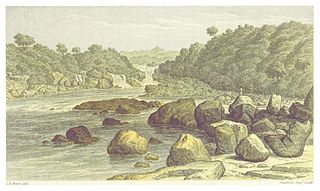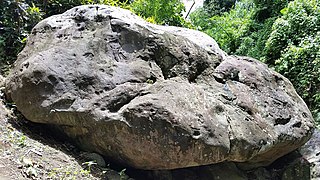The Corantijn, Corantijn or Courantyne River is the Border River between Suriname and Guyana. The Corantijn Basin is one of a number of archaeological sites located in the hinterland of Suriname, South America. [1] [2] The Suriname archaeological sites provide information on Indigenous Peoples who lived in Suriname before 1492. Most of the petroglyphs are in the Corantijn Basin site. Petroglyphs provide an important insight into the ceremonial, mythical and religious world of these precontact indigenous peoples. [3] [4]

The Courantyne/Corentyne/Corantijn River is a river in northern South America in Suriname. It is the longest river in the country.

Suriname, officially known as the Republic of Suriname, is a country on the northeastern Atlantic coast of South America. It is bordered by the Atlantic Ocean to the north, French Guiana to the east, Guyana to the west and Brazil to the south. At just under 165,000 square kilometers, it is the smallest sovereign state in South America. Suriname has a population of approximately 558,368, most of whom live on the country's north coast, in and around the capital and largest city, Paramaribo.

Guyana, officially the Co-operative Republic of Guyana, is a country on the northern mainland of South America. It is the only English speaking country in South America, and is culturally considered part of the Anglophone-Caribbean sphere. In addition it is one of the founding member countries of the Caribbean Community organization, (CARICOM). Guyana is bordered by the Atlantic Ocean to the north, Brazil to the south and southwest, Venezuela to the west, and Suriname to the east. With an area of 215,000 square kilometres (83,000 sq mi), Guyana is the third-smallest sovereign state on mainland South America after Uruguay and Suriname.
The site is also well known as the habitat of Pseudoplatystoma, a genus of several South American catfish. [5]

Pseudoplatystoma is a genus of several South American catfish species of family Pimelodidae. The species are known by a number of different common names. They typically inhabit major rivers where they prefer the main channels and tend to stay at maximum depth, but some species can also be seen in lakes, flooded forests, and other freshwater habitats. They have robust bodies, and are important food fish.
A genus is a taxonomic rank used in the biological classification of living and fossil organisms, as well as viruses, in biology. In the hierarchy of biological classification, genus comes above species and below family. In binomial nomenclature, the genus name forms the first part of the binomial species name for each species within the genus.

Catfish are a diverse group of ray-finned fish. Named for their prominent barbels, which resemble a cat's whiskers, catfish range in size and behavior from the three largest species alive, the Mekong giant catfish from Southeast Asia, the wels catfish of Eurasia, and the piraíba of South America, to detritivores, and even to a tiny parasitic species commonly called the candiru, Vandellia cirrhosa. Neither the armour-plated types nor the naked types have scales. Despite their name, not all catfish have prominent barbels. Members of the Siluriformes order are defined by features of the skull and swimbladder. Catfish are of considerable commercial importance; many of the larger species are farmed or fished for food. Many of the smaller species, particularly the genus Corydoras, are important in the aquarium hobby. Many catfish are nocturnal, but others are crepuscular or diurnal.









